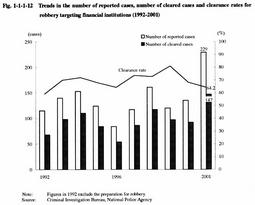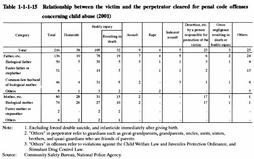| Previous Next Index Image Index Year Selection | |
|
|
4 Trends, etc. in peculiar penal code offenses (1) Trends in peculiar penal code offenses The penal code offenses that usually attract attention from the public are homicides for insurance money, various kinds of robberies, child abuses, card crimes, and organized crimes. Tables from 1-1-1-10 , 1-1-1-11 , 1-1-1-12 , 1-1-1-13 , 1-1-1-14 , 1-1-1-15 , 1-1-1-16 , 1-1-1-17 show the trends of these offenses.
Robbery targeting cash transit vehicles have numbered somewhere around 10 cases per year, after frequent occurrence in 1997. Regarding robberies targeting overnight supermarkets including 24-hour convenience stores (hereinafter referred to as "convenience store robberies, etc." in this part) and those targeting financial institutions, the number of reported cases has sharply increased in recent years. In 2001, robberies targeting post offices have increased remarkably, and the clearance rate for such robberies is 57.2%, which is higher than that for the total robbery. Convenience store robberies, etc. increased by 133 from the previous year, and the clearance rate fell sharply, decreasing by 16.8 points from the previous year to 30.9%. Robberies of these kinds tend to be imitated by others, and we should pay attention to future trends. Regarding child abuse that is less likely to be obvious, as well as domestic violence, it has increased every year, and it is necessary to be cautious about future trends. As for card crimes in 2001, the number of reported cases decreased by around 1,500 and the clearance rate increased by 9.1 points from the previous year, and it can be pointed out that card crimes decreased due to the fact that a law revision was enacted and enforced. Therefore, we should be cautious about effects of the revision of the law in the future. On the other hand, as for organized crimes, the number of cleared cases has rapidly increased from the previous year, with the number of types of crimes to which the law for the punishment of organized crimes is applied increased, and therefore, it can be suggested that organized crimes should be regulated by weighed punishments. (2) Legal action against peculiar penal code offenses The Law Concerning the Prevention of Child Abuse (Law No. 82 of 2000) was established on May 17, 2000 and came into force in November 2000. Child abuse under the Law means the abuse towards the child by a guardian. The guardian means a parent exercising parental power and a guardian for a minor or another person who actually takes the custody of a child, and the child means a person under 18 years old. Abuses are the acts such as physical abuse, sexual abuse, neglect or rejection, mental abuse, other than forced double suicide and infanticide immediately after giving birth. Though not having the special provisions for sanctions concerning crimes related to child abuse, the Law clearly mentioned that a person who commits such an offense should not be immune from being punished on the ground that he/she is the person who exercises parental power. After the Law was promulgated and came into force, child abuse has rapidly increased in the numbers of reported cases and persons cleared. In light of this, it seems that the constitution of the Law promoted reports of and clearances for child abuse cases.
Regarding card crimes, the Law for Partial Amendment of the Penal Code (Law No. 97, 2001) established an offense concerning electromagnetic records of payment cards, on the grounds that electromagnetic records including card information were illegally tapped and acquired, and that a credit card illegally copying the records often came to be used. This Law that was enacted on June 26, 2001 and came into force in July, 2001, is intended to additionally punish a person who has committed an act of illegally producing, or using electromagnetic records of payment cards, and moreover, it was newly designed for punishing the acts of assigning, lending, importing, or possessing a card using electromagnetic records which were illegally produced, acts of illegally obtaining, providing or storing information on the electromagnetic cards, and acts of preparing equipment and raw materials in order to illegally produce information on the electromagnetic records. Regarding global trends in countermeasures against organized crime, the penalty for organized crime has been generally increasing and related offenders have been deprived of their crime proceeds. To keep up with these trends, the Law For Punishment of Organized Crime, Control of Crime Proceeds and Other Matters (Law No. 136, 1999) was promulgated on August 18, 1999 and came into force in February 2000. Under the Law, if a person commits specific penal code offenses such as homicide, arrest and confinement, as acts corresponding to organized crime, the penalty will be increased and crime proceeds will be confiscated. In other words, a person who commits specific penal code offenses under the Law will be additionally punished in the case where (i) the offense is committed as a group activity by an organization that intended to commit an act corresponding to the offense or (ii) the offense is committed for the purpose of obtaining illegal interests for the group. As for these penal code offenses and other specific crimes, the Law also provides regulations to punish the acts of disguising, concealing, or receiving crime proceeds, and acts of changing corporate executives for the purpose of taking over the control of the business management of the corporation with crime proceeds. The Law further provides regulations concerning the confiscation, additional collection, and maintenance procedures related to crime proceeds in order to deprive an offender of illegal proceeds. Table 1-1-1-10 Trends in the number of cleared cases of homicides for insurance money (1992-2001) Table 1-1-1-11 Trends in the number of cases reported and cleared for robbery targeting cash transit vehicles (1992-2001) Fig. 1-1-1-12 Trends in the number of reported cases, number of cleared cases and clearance rates for robbery targeting financial institutions (1992-2001) Fig. 1-1-1-13 Trends in the number of reported cases, number of cleared cases and clearance rates for robberies targeting overnight supermarkets (convenience store robberies, etc.) (1992-2001) Table 1-1-1-14 Number of cleared cases and persons cleared for penal code offenses concerning child abuse Table 1-1-1-15 Relationship between the victim and the perpetrator cleared for penal code offenses concerning child abuse (2001) Fig. 1-1-1-16 Trends in the number of reported cases, number of cleared cases and clearance rates for card crimes (1992-2001) Table 1-1-1-17 Number of persons newly received by public prosecutors offices for offenses related to the Law For Punishment of Organized Crime, Control of Crime Proceeds and Other Matters (2000-2001) Explanation of termsPenal code offense : See Notes I-1-(1). Number of reported cases : See Notes I-2-(1). Number of cleared cases : See Notes I-2-(2). Number of persons cleared : See Notes I-2-(3). Clearance rate : See Notes I-2-(6). General penal code offense : General penal code offense refers to penal code offenses excluding professional negligence in traffic accidents. Professional negligence in traffic accidents : See Notes I-1-(4). Heinous offense : Heinous offense refers to homicide, robbery, robbery resulting in death or bodily injury, rape on the occasion of robbery, and rape on the occasion of robbery resulting in death or bodily injury. Incidentally, it includes arson in addition to the offenses above on the Criminal Statistics by the National Police Agency. Violent offense : Violent offense refers to bodily injury, bodily injury resulting in death, assault, intimidation, extortion, unlawful assembly with weapons, and Physical Violence Law violations. Property offense : Property offense refers to larceny, fraud, embezzlement, breach of trust, and illegal transaction of stolen property. Sexual offense : Sexual offense refers to rape, rape resulting in death or bodily injury, indecent assault, indecent assault resulting in death or bodily injury, public indecency, and distribution of obscene literature. Intellectual offense : Intellectual offense refers to fraud, embezzlement, forgery and counterfeiting, bribery and graft, and breach of trust. |







